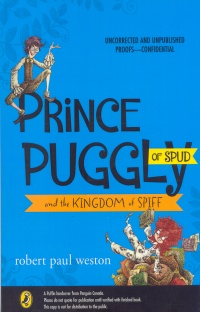| ________________
CM . . . . Volume XIX Number 20 . . . . January 25, 2013
excerpt:
This is the tale of two kingdoms, Spiff and Spud. The kingdom of Spiff is known for its fashion and Spud for its earthiness. Each kingdom has an individual who walks to a different drummer or fashion sense and who decides to leave his native land to find a place where that individual feels more part of the fabric. In the kingdom of Spud, the King (Walter) leaves his realm, thereby sending his subjects in a search of a monarch. They find Puggly O'Bungleton in a muddy kingdom to the west. The Spudlians decide he is not kingly material but rather princely and so crown him Prince Puggly of Spud. After the coronation, an invitation arrives in Spud addressed to Puggly and requesting his attendance at a party in Spiff. When Puggly arrives, its chief fashionista, Miss Ruby Larue, points out the invitation was a fake, and it was all a ruse. Humiliated, Puggly runs off, heading into the woods. Meanwhile, in Spiff, King von Fop is having an argument with his daughter, Francesca, over what is appropriate attire for the party. Francesca adores her comfortable pajamas and loves reading. Her father, King von Fop, believes her dress inappropriate and reading, a useless pastime. This response sends Francesca into the woods where she meets up with Puggly. Puggly and Fran go back to Spud. Miss LaRue develops a line of clothing that rots, thereby building her wealth but leaving everyone else au naturel. Driven by his love for his daughter Francesca, King von Fop shows up in Spud. Reunited with her, King von Fop proclaims his love for her and admits the new line of fashion is ridiculous. A party is thrown for Puggly, King Walter shows up, and all ends happily ever after with everyone being left to their own fashion sense. The excerpt, included in this review is taken from the speech Puggly delivers at the party delivering the moral of this story: tolerance. At the end of the narrative, readers learn that this story, written in rhyming couplets, is Puggly's, great-grandmother's memoire. The rhythmic text will be fun for accomplished readers but difficult for those who do not have sufficient vocabulary to read through the text with the required rhythm. As noted in the Kirkus review (September 2008) of Zorgamazoo, Weston's previous offering written in the same rhyming style, "the language is often a slave to the rhyme." A student review of Zorgamazoo pointed out the rhyming couplet style required slow reading as he needed to hear each word in his head. I found myself in the same boat as this young reader, frequently re-reading passages that, upon first reading, seemed to be missing the required rhythmic accents. Some of the text is presented in different fonts, in different sizes, and, in some cases, one line of a couplet is laid out on the page on different lines to 'illustrate' the action (e.g. a balloon dropping p. 192). The intricate plot drives the story. The characters are bound to the plot and are one-dimensional . I found the plot difficult to follow at times. It required my undivided attention and required re-reading for clarification. The settings are thinly sketched, and again the need to maintain the rhyming couplets restricts in-depth description. Nevertheless, Weston put a great deal of effort into the rhythmic style of his offering, and it is quite a good romp. I do think it will be a challenge for slow or struggling readers, and the varying fonts will frustrate those with reading challenges such as dyslexia. Those who had success with Zorgamazoo (Vol. XV, No. 2, Sept. 12, 2008) may wish to add this to their collection. Recommended with reservations. Ruth McMahon, a professional librarian in Alberta, works in a middle school with two middle school aged daughters.
To comment
on this title or this review, send mail to cm@umanitoba.ca.
Copyright © the Manitoba Library Association. Reproduction for personal
use is permitted only if this copyright notice is maintained. Any
other reproduction is prohibited without permission.
NEXT REVIEW |
TABLE OF CONTENTS FOR THIS ISSUE
- January 25, 2013.
AUTHORS |
TITLES |
MEDIA REVIEWS |
PROFILES |
BACK ISSUES |
SEARCH |
CMARCHIVE |
HOME |
